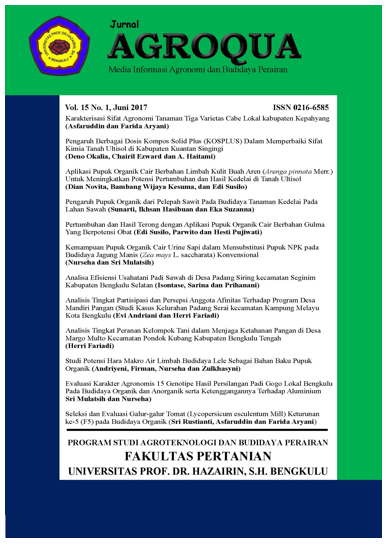Effectiveness of Chitosan in Feeding on Organoleptic of Dumbo Catfish(Clarias gariepinus)
DOI:
https://doi.org/10.32663/ja.v21i2.3783Keywords:
dumbo catfish, chitosan, organolepticAbstract
The cultivation of dumbo catfish (Clarias gariepinus) has great potential to be a profitable business as long as farmers can overcome obstacles such as odors in ponds and fish. Maintenance ponds that are not paid enough attention to make the aroma of the resulting dumbo catfish slime stronger. In overcoming this problem, we need a material that can reduce the odor in dumbo catfish. One natural ingredient that can improve water quality and reduce odor in catfish is by mixing chitosan in the feed. The purpose of this study was to evaluate the effectiveness of chitosan in removing odors and to determine the best dose of chitosan for eliminating odors in dumbo catfish. This study used an experimental method with a completely randomized design (CRD). The treatments used were (P0 = without chitosan; P1 = 2% chitosan; P2 = 4% chitosan; P3 = 6% chitosan, with 3 repetitions for each treatment). Parameters observed included organoleptic tests including aroma, texture, and taste to determine the effect of chitosan on dumbo catfish meat. The results of the study showed that the addition of chitosan to feed had a significant effect on eliminating odors in the organoleptic (aroma, texture, taste) of African catfish. The best dose of chitosan to remove odor in dumbo catfish (Clarias gariepinus) is at P2 (dose 4%) and P3 (6%).
References
Downloads
Published
Issue
Section
License
Copyright (c) 2023 Nanda Syahputra, Suri Purnama Febri, Siti Komariyah, Teuku Fadlon Haser, Ika Rezvani Aprita

This work is licensed under a Creative Commons Attribution 4.0 International License.
Authors who publish with this journal agree to the following terms:
- Authors grant the journal right of first publication with the work simultaneously licensed under a Creative Commons Attribution 4.0 Internasional (CC BY 4.0) Licence that allows others to use and share the work with an acknowledgment of the work's authorship and initial publication in this journal.
- The author(s) still hold the copyright of his/her/their work and retain publishing rights without restrictions such as (but not limited to) patent right, lecture, book and reproduce the article for own purposes.
















